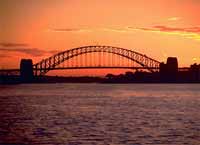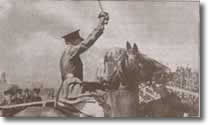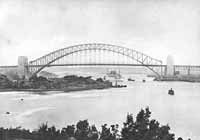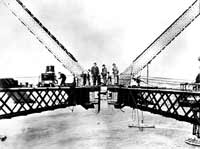| 銆愰檮鍥俱€慡ydney Harbour Bridge | |||||||||||||||||||||||||||||||||||||||||||||||||||||||
http://english.dbw.cn銆€銆€
2007-12-01 20:28:44
|
|||||||||||||||||||||||||||||||||||||||||||||||||||||||
The Sydney Harbour Bridge is one of Australia's most well known and photographed landmarks. It is the world's largest (but not the longest) steel arch bridge with the top of the bridge standing 134 metres above the harbour. Fondly known by the locals as the 'Coathanger', the Sydney Harbour Bridge celebrated its 70th birthday in 2002, with its official opening in March 1932. A history of the Sydney Harbour BridgeIt was as early as 1815 that Francis Greenway proposed building a bridge from the northern to the southern shore of the harbour. It took some time for this to become a reality with design submissions invited in 1900. All the submissions were considered unsuitable and so the momentum for the bridge crossing stopped. However, after the First World War more serious plans were made, with a general design for the Sydney Harbour Bridge prepared by Dr J J C Bradfield and officers of the NSW Department of Public Works. The New South Wales Government then invited worldwide tenders for the construction of the Bridge in 1922 and the contract was let to English firm Dorman Long and Co of Middlesbrough. The Sydney Harbour Bridge construction started in 1924 and took 1400 men eight years to build at a cost of 拢4.2 million. Six million hand driven rivets and 53,000 tonnes of steel were used in its construction. It now carries eight traffic lanes and two rail lines, one in each direction, but at the time of its construction the two eastern lanes were tram tracks. They were converted to road traffic when Sydney closed down its tram system in the 1950s.
An interesting pastThe Bridge has an interesting past including its opening on 19 March 1932. The NSW Premier, the Honourable John 'Jack' T. Lang, officially declared the Bridge open and instead of cutting the ribbon to signify the momentous event, Captain Francis De Groot of the political group The New Guard slashed the ribbon with his sword. He believed that the only person to open the Bridge should be a member of the Royal family. As many as 800 families living in the Bridge's path were relocated and their homes demolished without any compensation given when the Bridge started construction. Sixteen workers lives were lost during construction of the Bridge. Flying under the BridgeIt is reported that in 1943 a flight of 24 RAAF Wirraways flew under the Sydney Harbour Bridge, with one of the pilots changing his flight path at the last moment to go over the top of the Bridge only just clearing it in time. There is another story of the Americans flying under the Harbour Bridge, with one Kittyhawk flying under in about February 1942 and two Kittyhawks in May 1942. Again in May 1942, the Dutch flew three aircraft of the 18 Squadron NEI-AF under the Bridge in formation and then circled back to do another flight under the Bridge in a single line. On 22 October 1943, Flight Lieutenant Peter Isaacson and his crew flew the huge Australian Lancaster, Q for Queenie, under the Harbour Bridge during a tour around Australia to raise funds for the war effort.
Climbing the BridgeBridgeClimb started in 1998 and attracts tourists and locals alike to climb the monument. After climbing through catwalks and up ladders and stairs, the view is absolutely breathtaking. There are day, twilight and night climbs and a group of twelve will leave for a climb every ten minutes. The safety precautions taken include a blood alcohol reading and a Climb Simulator, which shows Climbers the climbing conditions that might be experienced on the Bridge. By all reports, BridgeClimb is fantastic and one of the 'must dos' while on a trip to Sydney with royals and celebrities such as Prince Frederik and Princess Mary of Denmark, Matt Damon, Hugo Weaving, Sarah Ferguson, Cathy Freeman, Kylie Minogue and Kostya Tszyu all having done the Climb. The Pylon LookoutThe Pylon Lookout is at the southern eastern end of the Bridge (the Rocks end) and visitors can go and see an exhibition about the Bridge and well as see the spectacular 360掳 view from the top of the pylon. Did you know...The top of the arch actually rises and falls about 180 mm due to changes in the temperature! In 1932, 96 steam locomotives were positioned in various ways to test the load capacity of the Bridge. One of Australia's well known celebrities, Paul Hogan, was one of the painters contracted to give the Bridge another 270,000 litre coat of paint. When the Bridge opened, it cost a horse and rider three pence and a car six pence to cross. Now horse and riders cannot cross, you can bicycle across in a special lane and walk across the Bridge for free. Cars cost around A$3.30 for a southbound trip and it is free to go northbound. In 1932, the average annual daily traffic was around 11,000 and now it is around 160,000 vehicles per day. The Sydney Harbour Tunnel was built to cope with ever increasing harbour traffic problems and opened in August 1992 . It is 2.3 kilometres long and cost A$554 million to construct. It is strong enough to withstand the impact of earthquakes and sinking ships. It carries around 75,000 vehicles a day. The Tyne Bridge in Newcastle-upon-Tyne, England is a much smaller version of the Sydney Harbour Bridge, its length measuring 397 metres and the main span 161 metres. There is much controversy surrounding the two bridges and which one may have been a model for the other. Although the Tyne Bridge was opened in 1928 - four years before the Harbour Bridge was opened - the tender was submitted and contract signed for the Sydney Harbour Bridge in March 1924. The designs for the Harbour Bridge were put forward by Dr. J C Bradfield before this date. The tender for the Tyne Bridge was accepted and contract signed later that year in December 1924.
Some interesting facts about the Bridge
聽 聽 聽 |
|||||||||||||||||||||||||||||||||||||||||||||||||||||||
| Author锛? 銆€銆€銆€Source锛? www.cultureandrecreation.gov.au 銆€銆€銆€ Editor锛? 楂樻 | |||||||||||||||||||||||||||||||||||||||||||||||||||||||
 涓枃绠€浣?/a>銆€|銆€
涓枃绠€浣?/a>銆€|銆€














